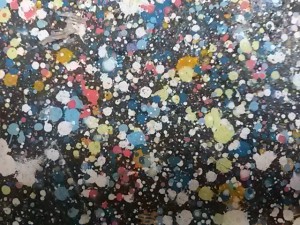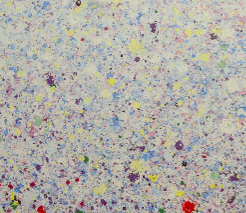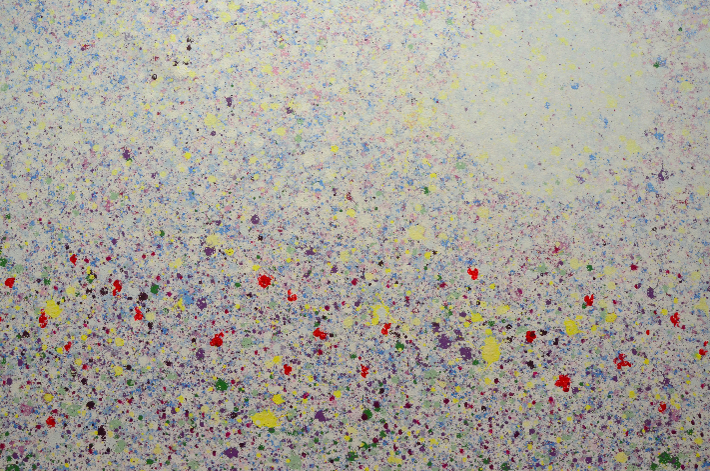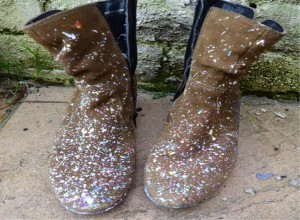As well as being a facilitator I practise art- I make paintings in my studio. Sometimes these two activities seem quite separate but more and more they are coming together and informing my work and how I operate. I often see parallels and gain insights from my painting and my work with organisations. In this series of articles I shall start documenting some of these insights which I am broadly titling ‘Art and Leadership’.
I have no idea how this will progress but I feel it’s important to make a start. I may even come back to this at a later date and add to it as I learn more.
(Thanks to David Hain for seeing the potential value in this area of work).
Article 1: Painting- the process, the experience
“I am currently painting using the 1940’s technique of ‘action painting’ (think Jackson Pollock). For me this involves throwing and splattering paint onto a large sheet of canvas. Before this I would paint more traditionally, with a brush, aiming to get a likeness of someone or something. This method is so freeing in comparison it has changed my whole experience of painting. Today I wrote in my studio notebook ‘This isn’t painting- this is about bravery’.
I have a sheet of canvas, liquid paint, there are no markings to follow, so I have to go with my instinct. I throw the paint. It could land anywhere. It may be a small splodge or a tiny dot I have little control. I have to trust the movement I make is the right movement for the painting. If it isn’t and a stray splodge of colour looks out of place I can dab it down to dullen the effect- but it will look out of place. I need to have the courage of my conviction and let paint fall where it falls- and not try and change it.
 It’s a very messy process. My shoes are covered with dots of paint. The floor is speckled and slippery. Everything needs to be covered up and taken off the walls or it will be covered in paint too. The focus in my studio is purely on the painting at hand.
It’s a very messy process. My shoes are covered with dots of paint. The floor is speckled and slippery. Everything needs to be covered up and taken off the walls or it will be covered in paint too. The focus in my studio is purely on the painting at hand.
It takes a lot of paint- more so than the traditional painting process. It is thus more expensive to create in this way and the odds of the painting looking good are probably pretty low- I doubt my first few attempts will be fit for any wall.
But as I paint nothing else exists. It’s all about the consistency of paint, getting the right shade that will fit with the rest of the colours, not falling off the chair you’re standing on. For two-three hours you can get lost in colour and the physical process of painting that eventually tires the body.
 There are points of excitement when a new colour is added and everything comes to life- ‘This is it’ you think. You take in a breath and gaze in wonder. Then you have to ask is there more? Could there be more? Shall I introduce another colour? And you move forward.
There are points of excitement when a new colour is added and everything comes to life- ‘This is it’ you think. You take in a breath and gaze in wonder. Then you have to ask is there more? Could there be more? Shall I introduce another colour? And you move forward.
Then it is time to stop. The paint may have ran out, you’ve added as much as you can, it needs to dry, it needs to rest or else the colours will flow into each other and lose their own definition. Will this be it- is it finished? You won’t know until you next see it.”
How does this experience of panting in a studio relate to leadership?
I am currently painting using the 1940’s technique of ‘action painting’. For me this involves throwing and splattering paint onto a large sheet of canvas. Before this I would paint more traditionally, with a brush, aiming to get a likeness of someone or something. This method is so freeing in comparison it has changed my whole experience of painting. Today I wrote in my studio notebook ‘This isn’t painting- this is about bravery’.
The leader who experiments with new methods, new approaches, engages in the process of creating something new and innovation requires a whole heap of bravery. Where does this bravery come from? There are no guarantees this is going to work, it is new territory. Maybe the feeling of freedom, of adventure serves as fuel for the bravery required.
The studio itself is the container for the work, just as an organisation is for the leader. The canvas is the project.
I have a sheet of canvas, liquid paint, there are no markings to follow, so I have to go with my instinct. I throw the paint. It could land anywhere. It may be a small splodge or a tiny dot I have little control. I have to trust the movement I make is the right movement, the right gesture for the painting. If it isn’t and a stray splodge of colour looks out of place I can dab it down to dullen the effect- but it will look out of place. I need to have the courage of my conviction and let paint fall where it falls- and not try and change it.
Instinct, trust, lack of control, lack of certainty, courage- key themes in leadership. Trust is often considered in terms of building trust with your team- but here it’s about trusting yourself, trusting your own instinct. Which direction do you take? What areas do you invest in? Sometimes there is no evidence or market research to fall back on- so you have to trust that you will make ‘the right movement, the right gesture’. Also, how can you get others to trust you when you don’t trust yourself?
The second part of this ‘let paint fall where it falls’ could be likened to allowing people to make mistakes, including yourself. Accepting that this is part of the process and perhaps even reframing them so they are not even considered ‘mistakes’.
It’s a very messy process. My shoes are covered with dots of paint. The floor is speckled and slippery. Everything needs to be covered up and taken off the walls or it will be covered in paint too. The focus in my studio is purely on the painting at hand.
To create something new and wonderful, the path is not straight forward but requires a series of iterations, experiments- it can be messy. It also requires a singularity of focus. Brush everything aside and focus purely on what you want to create. Safeguard any existing goods or services so you can create more freely.
It takes a lot of paint- more so than the traditional painting process. It is thus more expensive to create in this way and the odds of the painting looking good are probably pretty low- I doubt my first few attempts well be fit for any wall.
There are no guarantees new things will work. They will cost time, energy, commitment and other tangible resources. That’s just part of the process any leader or innovator needs to accept.
But as I paint nothing else exists. It’s all about the consistency of paint, getting the right shade that will fit with the rest of colours, not falling off the chair you’re standing on. For two-three hours you can get lost in colour and the physical process of painting that eventually tires the body.
The magical space of being in flow- when you are using your capabilities to the max; when you are at your optimum. Mindfulness- being present in the moment and the energy that is happening within it. This section not only applies to leaders but for anyone. Doing work that is best suited to you that gives you this sense of flow and mindfulness is the most productive place to be for you and the organisation.
There are points of excitement when a new colour is added and everything comes to life- ‘This is it’ you think. You take in a breath and gaze in wonder. Then you have to ask is there more? Could there be more? Shall I introduce another colour? And you move forward.
One element of this is about celebrating success along the way but a bigger element is about those dilemmas leaders often have to face. Do you stay put and stick to what you have or do you push for more? Easier to practise this through painting.
Then it is time to stop. The paint may have ran out, you’ve added as much as you can, it needs to dry, it needs to rest or else the colours will flow into each other and lose their own definition. Will this be it- is it finished? You won’t know until you next see it.
As a leader you do your best work, investing in your people, creating an environment for them to flourish. Then you have to sit back and watch for a while and see if your work is done or more is required from you.
My question: Through painting might a person be able to practise leadership skills? Practice dealing with uncertainty, dilemmas, decision making? Practice mindfulness? It could be a parallel learning ground, ‘a playground’ for existing or potential leaders. Might it be time for leadership to get colourful and messy?


